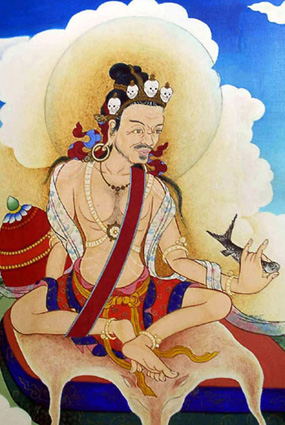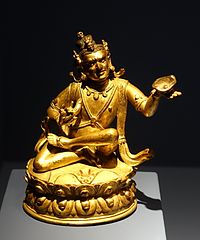Tilopa
Tilopa (T. ti lo pa ཏི་ལོ་པ་) (988–1069) was an Indian tantric practitioner who is counted among the eighty-four mahasiddhas. In Tibet, and he is known as the originator of the Kagyu lineage and the teacher of Naropa.
Justin von Bujdoss states:
- Tilopa was a mahasiddha, or great adept, who likely lived in the region now known as West Bengal, India, and Bangladesh during late tenth to early eleventh centuries. Not much is known about the details of his life. The existing biographies tell us that he was a cowherd and perhaps someone with a natural talent for meditation and mystical experiences. What is clear is that he became a very experienced meditator who developed a profound understanding of the mind. Like many of the other famed eighty-four mahasiddhas from the Indian subcontinent, Tilopa was instrumental in creating and refining many core spiritual practices that later spread throughout the Himalayan region. He is remembered as human progenitor of the Kagyu lineage of Tibetan Buddhism, and as such, he is regarded as one of the most famous mahasiddhas from the Indian subcontinent. He was instrumental in teaching Naropa his special tantric practices, some of which, including mahamudra, became known as the six yogas of Naropa. Naropa was the teacher of Marpa, the first to bring these instructions from India to Tibet.[1]
Traditional biography
According to tradition, Tilopa was born into a Brahmin family in Northern India. He became a monk at a young age, but later felt compelled to seek out and study with a variety of tantric teachers. He then lived as a wondering yogi and practiced tantra in secret.
For many years, Tilopa worked as a servant for a prostitute name Barima in Bengal. During the day, he was grinding sesame seeds for his living.[2]
At Pashupatinath temple premise in Kathmandu, there are two caves where Tilopa attained Siddhi and initiated his disciple Naropa.
The six nails
Tilopa's "six nails," or "six words of advice" is one of the best-known of Tilopa's meditation instructions.[1] In Tibetan, the teaching is called "six nails of key points" (gnad kyi gzer drug).[3]
Justin von Bujdoss states:
- At its heart, this meditation instruction is about allowing what is happening in the present moment to happen with simple awareness. It’s about resting the mind and allowing ourselves, by reorienting our experience of mind, to cut through the discursive, reactive patterning that our ordinary samsaric awareness or samsaric mind is focused on. It’s almost as if Tilopa is trying to point a finger at what the experience of meditation or what the experience of mahamudra is all about.[1]
McLeod translation
The Tibetan source text for the six nails consists of six words in Tibetan.[4] Ken McLeod rendered this text in English (with a brief explanation of each term) as follows:[1]
- Don’t recall. (Let go of what has passed.)
- Don’t imagine. (Let go of what may come.)
- Don’t think. (Let go of what is happening now.)
- Don’t examine. (Don’t try to figure anything out.)
- Don’t control. (Don’t try to make anything happen.)
- Rest. (Relax, right now, and rest.)
Watts-Wayman translation
An earlier translation circa 1957 by Alan Watts and Dr. Alex Wayman rendered Tilopa's "six nails" as:
- No thought, no reflection, no analysis,
- No cultivation, no intention;
- Let it settle itself.
In a footnote, Watts cited a Tibetan source text at partial variance with McLeod's in sequence and syntax, namely:
- Mi-mno, mi-bsam, mi-dpyad-ching,
- Mi-bsgom, mi-sems, rang-babs-bzhag.
Based on an "elucidation" provided by Wayman, Watts explained that:
- Mi-mno is approximately equivalent to the Zen terms wu-hsin or wu-nien, “no-mind” or “no thought.”
- Bsam is the equivalent of the Sanskrit cintana, i.e., discursive thinking about what has been heard, and
- dpyad is mimamsa, or “philosophical analysis.”
- Bsgom is probably bhavana or the Chinese hsiu, “to cultivate,” “to practice,” or “intense concentration.”
- Sems is cetanā or szu, with the sense of intention or volition.
- Rang-babs-bzhag is literally “self-settle-establish,” and “self-settle” would seem to be an almost exact equivalent of the Taoist tzu-jan, “self-so,” “spontaneous,” or “natural.”[5]
Watts had studied Chinese, and Wayman was a Tibetologist and professor of Sanskrit associated with UCLA and later Columbia University.
Khenpo Konchog Gyaltsen translation
Khenpo Konchog Gyaltsen Rinpoche translated the six nails as follows:
- Do not ponder, think, or cognize. Do not meditate or examine. Leave the mind to itself.[6]
The Ganges Mahamudra Instructions
The Ganges Mahamudra Instruction is a text of advice that Tilopa said to Nāropa on the banks of the River Ganges in India.
The following translations of this text are available:
- Ina Bieler (2021),
 The Ganges Mahāmudrā Instructions, Lotsawa House
The Ganges Mahāmudrā Instructions, Lotsawa House - Thrangu Rinpoche (2019), Johnson, Clark, ed., Tilopa's Wisdom: His Life and Teachings on the Ganges Mahamudra, Snow Lion
- Sangyes Nyenpa (2014), Tilopa's Mahamudra Upadesha: The Gangama Instructions with Commentary, Shambhala Publications
- Keith Dowman (1977), Tilopa's Mahamudra Teaching to Naropa
Quotations
In the Ganges Mahamudra Instructions, Tilopa states:
- Alas! Look closely at worldly phenomena. Like dreams and illusions, they cannot last; dreams and illusions do not actually exist. Therefore, renounce them and abandon worldly activities.
- Having cut through the bonds of attachment and aversion to people and places, meditate alone in forests and mountain retreats. Remain there in a natural state of non-meditation. When you attain non-attainment, you attain mahāmudrā.[7]
Tilopa also said to Nāropa:
- It is not the appearances that bind you, but your clinging to these appearances. Therefore, let go of your clinging, Nāropa![8]
Tilopa also said:
- Do not ponder, think, or cognize. Do not meditate or examine. Leave the mind to itself.[6]
References
- ↑ 1.0 1.1 1.2 1.3 von Bujdoss 2019, Tilopa's Six Nails.
- ↑ Kagyu Lineage History: Tilopa
- ↑ Tsele Natsok Rangdrol (tr. Erik Pema Kunsang), Lamp of Mahamudra, Shambhala, 1989, p. 72 and n. 18.
- ↑ mi mno, mi bsam, mi sems, mi dpyod, mi sgom, rang sar bzhag
- ↑ The Way of Zen by Alan Watts (© Pantheon NY, 1957), Vintage Books paperback 1999, p. 79 and n. 3
- ↑ 6.0 6.1 Gampopa 1998, Chapter 17.
- ↑ Ina Bieler (2021),
 The Ganges Mahāmudrā Instructions, Lotsawa House
The Ganges Mahāmudrā Instructions, Lotsawa House
- ↑ Brunnhölzl 2012, Chapter: "The Middle Way without a Middle".
Sources
- Brunnhölzl, Karl (2012), The Heart Attack Sutra: A New Commentary on the Heart Sutra, Snow Lion
- Chökyi Nyima (1994). Union of Mahamudra and Dzogchen. Rangjung Yeshe Publications. ISBN 978-962-7341-21-5.
- Gampopa (1998), The Jewel Ornament of Liberation, translated by Khenpo Konchog Gyaltsen Rinpoche, Snow Lion
- Blo-Gros, Mar-Pa Chos-Kyi; (Na-ga.), Saṅs-rgyas-bstan-dar (1995). The Life of the Mahāsiddha Tilopa. Library of Tibetan Works and Archives. ISBN 978-81-85102-91-7.
- von Bujdoss, Justin (2019), Modern Tantric Buddhism, North Atlantic Books
External links
- Tilopa’s Six Nails, By Justin von Bujdoss, Tricyle, 2018
| This article includes content from Tilopa on Wikipedia (view authors). License under CC BY-SA 3.0. |

